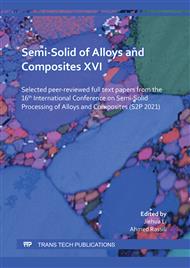p.119
p.127
p.133
p.140
p.149
p.156
p.163
p.172
p.178
Structure Optimization of Semi-Solid Die Cast Steering Knuckle and its Experiment Verification
Abstract:
Steering knuckles are vital functional and structural components in automotive suspension systems, requiring high strength, high ductility, and complex shapes. In this study, an aluminum alloy knuckle with the semi-solid die casting process was developed to replace the conventional steel components. This research aims to optimize product design based on both structural simulation and casting process simulation to avoid defects and to meet mechanical requirements. Furthermore, the optimal design solutions need to be verified through the filling experiments and defect analysis. The results show that the removal of support rib located in the thick area of the shock absorber mounting arm is helpful to avoid the rewelding defects in the filling frontier of the SSM melt. Besides, the position of the steering rod is of medium thickness, and two ribs from different directions come together to support that area. Rewelding defects were detected when two ribs come together. To avoid rewelding defects in local areas of steering rod position, the ribs were reduced to uniform wall thickness. Thus, the local flow state was modified and the SSM melt was reinforced shear action. Ultimately, by controlling all the processes of the SSM die casting process, the high performance of aluminum knuckle was successfully developed.
Info:
Periodical:
Pages:
149-155
Citation:
Online since:
January 2022
Authors:
Price:
Сopyright:
© 2022 Trans Tech Publications Ltd. All Rights Reserved
Share:
Citation:


